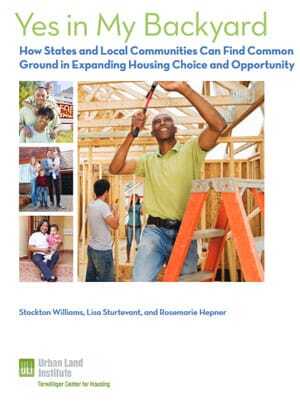State governments, in partnership with cities and other local jurisdictions, can and should do more to promote housing development and choice through smarter local land use policies and incentives, according to a new ULI report, Yes in My Backyard .
Rising housing costs are creating hardships for millions of U.S. households and taking a toll on economic growth—a problem made worse by local zoning and land use regulations and development review processes that impede affordable housing development, the report explains. While municipalities have more autonomy in some states than in others, states do have significant power to affect these regulations. However, the report notes, relatively few states have seized opportunities to deploy their authority and resources to help localities plan for and accommodate housing development through land use and zoning policies.
“At a time when states and cities are often at odds over hotly contested social and economic issues, land use reform to expand housing choice and opportunity can constitute common ground,” says Stockton Williams, principal author of the report and executive director of ULI’s Terwilliger Center for Housing, which published the report. “State and local collaboration on housing can create a lower cost of doing business, a more efficient real estate market, and a wider array of options for buyers and renters across the income spectrum.”
The report suggests five ways that states can help cities and counties promote the development of sufficient housing supply, primarily through their land use powers:
- Ensure that localities and regions are assessing their housing needs for the future. Because many communities do not analyze their housing needs or assess the importance of housing to economic growth, states should establish and enforce workable standards.
- Provide incentives to local communities to zone for new housing. Zoning often needs to be modified to allow for and encourage the development of needed new housing. States can support communities’ efforts with financial and technical assistance.
- Reduce regulatory requirements that increase costs and stifle development. States can use their authority and creativity to cut the regulatory red tape that unnecessarily makes housing more expensive.
- Authorize cities to invest their own resources linked to pro-housing land use. Even with appropriate zoning, local jurisdictions often need state approval to offer their own incentives for construction of below-market rate housing.
- Enable local communities to overcome unreasonable neighborhood opposition. Community opposition can drive up the cost of—or completely derail—the construction of new housing. States can provide mechanisms to moderate “not in my backyard” (NIMBY) opposition and make it easier to build housing needed to support local growth.
These approaches are being deployed successfully in some states, resulting in increased housing supply in many communities, as described in the report’s examples and case studies. The 13-year-old Massachusetts Smart Growth Zoning Overlay District Act has aided in the development of more than 3,300 housing units, with over 1,000 more in the pipeline. Connecticut’s Incentive Housing Zones program, which provides municipalities with technical assistance and financial incentives to create zoning districts that can accommodate additional housing, has helped create some 1,700 housing units. California is aiming to reduce the cost of affordable housing development through parking reduction and accessory dwelling unit laws. A Washington state law allows cities to exempt rental or owner-occupied multifamily properties in designated areas from property taxes for eight to 12 years. Utah’s Neighborhood Development Act, as amended, permits use of tax increment financing for redevelopment activities, requiring a 20- percent allocation toward affordable housing for certain types of projects.
The report examines the role that states can play in helping local communities overcome the NIMBY issue. Dating to 1969, the Massachusetts Comprehensive Permitting and Zoning Appeal Law allows developers to bypass local review processes for projects with specified minimum levels of affordable housing. It is estimated that this state law, known as Chapter 40B, has spurred the development of more than 68,000 housing units statewide, including 35,000 that are affordable to households with incomes below 80 percent of the area median income.





